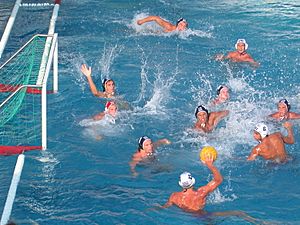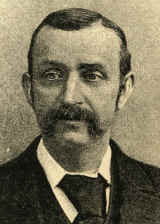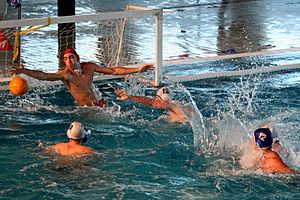Water polo facts for kids

Greece (white) and Hungary (blue) play a water polo match at the World Junior Championships 2004 in Naples, Italy.
|
|
| Highest governing body | FINA |
|---|---|
| Nicknames | Polo, wopo, waterfootball, poolball |
| Created | 19th century, Scotland, United Kingdom |
| Characteristics | |
| Contact | Full-contact |
| Team members | 7 per side (6 field players and 1 goalkeeper) |
| Mixed-sex | Separate competitions |
| Type | Aquatic sport, team sport, ball sport |
| Equipment | Water polo ball, water polo goal, water polo cap |
| Venue | Water polo pool |
| Glossary | Glossary of water polo |
| Presence | |
| Country or region | Worldwide |
| Olympic | Part of the Summer Olympic programme since 1900; women's since 2000 |
| World Games | Women's: 1981 |
Water polo is an exciting team sport played in the water. Two teams, each with seven players, try to score goals. They do this by throwing a special ball into the other team's goal. The team that scores the most goals by the end of the game wins!
Each team has six players who swim around and one goalkeeper. All players, except the goalie, play both offense (trying to score) and defense (trying to stop the other team). Water polo is usually played in a deep pool. This means players cannot touch the bottom.
In a game, players mostly swim to move. They also tread water (often using a special "eggbeater kick"). Passing the ball and shooting at the goal are key skills. Teamwork, smart thinking, and knowing what's happening around you are very important. Water polo is a tough and active sport. Many people say it is one of the hardest sports to play.
Special gear for water polo includes a water polo ball. This ball floats on the water and comes in different colors. Players also wear numbered and colored caps. There are two goals, which can float or be fixed to the pool sides.
The game is believed to have started in Scotland in the mid-1800s. A person named William Wilson likely created it in the 1870s. It was a bit like "water rugby" back then. The game grew and became popular in many places. These include parts of Europe, the United States, Brazil, China, Canada, and Australia.
Contents
History of Water Polo
The story of water polo as a team sport began in the mid-1800s. It started in England and Scotland. Back then, water sports and swimming races were popular at fairs. Men's water polo was one of the first team sports in the modern Olympic games. This happened in 1900.
Today's game has teams of seven players. Up to six more players can be substitutes. The water polo ball is similar in size to a soccer ball. But it is made of special airtight nylon.
The rules of water polo were first made in Great Britain in the late 1800s. William Wilson is thought to have written these rules. He was likely the first manager of the Arlington Baths Club in Glasgow. The first games of "aquatic football" were played there. They used a ball made of India rubber. This "water rugby" later became "water polo." The name "polo" comes from the Balti word pulu, which means ball.
Early games were very physical. Players could use strength and hold opponents underwater to get the ball. Goalies stood outside the playing area. They would jump in to stop anyone trying to score by putting the ball on the deck.
Where Water Polo is Played
Water polo is now popular in many countries. It is especially big in Europe. Countries like Spain, France, Netherlands, Germany, Italy, Croatia, Hungary, Serbia, Montenegro, Greece, and Romania love the sport. It is also popular in Australia, Brazil, Canada, and the United States.
Some countries have two main types of competitions. One is a top league for the best clubs. Teams play each other twice in a "round-robin" style. The other is a "cup" tournament. This is a "single-elimination" style, meaning if you lose, you are out. Both top and smaller clubs can join the cup.
Rules of the Game
The rules of water polo explain how the game is played. They cover procedures, equipment, and how officials manage the game. These rules are mostly the same around the world. But there can be small differences depending on the region or the group in charge.
Important groups that set water polo rules include FINA. This is the international organization. LEN handles European matches. The NCAA sets rules for college games in the US. The NFHS does the same for high schools. The IOC sets rules for Olympic events.
Player Positions
Each team has seven players in the water at one time. Six are field players, and one is the goalkeeper. Unlike many team sports, players often change positions during the game. They move where they are needed.
The main positions are a center forward, a center back, two wing players, and two drivers. Players who are good at all positions are called "utility players." They often come off the bench. Some body types are better for certain positions. Left-handed players are especially wanted on the right side of the field. This helps teams attack from both sides.
Offensive Positions
Offensive positions help a team score goals. They include:
- Center forward: Also called a "set" or "hole." This player is usually near the opponent's goal, in the middle.
- Wings: Two players positioned near the 2-meter line, just outside the goal posts.
- Drivers: Two players usually near the 5-meter line, around the goal posts.
- Point: This player is usually behind the 5-meter line, in the center. They are farthest from the goal.
The wings, drivers, and point are often called "perimeter players." The center forward usually directs the attack. The center is closest to the goal. This allows them to take powerful shots from up close.
Defensive Positions
Defensive positions are similar to offensive ones, but they focus on stopping the other team. For example, the center forward on offense becomes the "hole D" on defense. This player guards the opposing team's center forward.
Defense can be played in different ways:
- Man-to-man: Each defender guards one specific opponent.
- Zone: Defenders cover an area instead of a specific player. For example, a 2–4 zone has four defenders along the goal line.
- Combination: Sometimes, teams mix man-to-man and zone defense. An "M drop" defense is an example. Here, the point defender moves into a zone to better guard the center. This also gives wing defenders a clear path for a fast counter-attack if they get the ball.
Goalkeeper's Role
The goalkeeper has a very important job. Their main role is to block shots from going into the goal. They also guide their defense. They tell teammates about threats or open spaces. The goalkeeper usually starts the team's offense. They pass the ball across the pool to an attacker. It is common for a goalie to make a pass that leads to a goal on a fast break.
Goalies have special rules that other players do not. But these rules only apply within the five-meter area in front of their own goal:
- They can punch the ball with a closed fist.
- They can touch the ball with two hands.
If a field player commits a foul that would get them ejected, a goalie's foul might lead to a five-meter shot against them. Also, if a goalie pushes the ball underwater, it is a penalty shot. For field players, this would just be a turnover.
Fun Variations of Water Polo
Water polo has some cool variations:
- Inner tube water polo: In this game, players (except the goalie) float in inner tubes. Because they float, players use less energy than in regular water polo. This makes it easier for casual players to enjoy the game. They do not need the intense training of traditional water polo.
- Surf polo: This version of water polo is played on surfboards. It started on the beaches of Waikiki in Hawaii in the 1930s and 1940s. Louis Kahanamoku, brother of the famous Duke Kahanamoku, is said to have created it.
- Canoe polo: Also called kayak polo, this is one of the eight types of canoeing in the UK. Players call it simply "polo." It mixes paddling and ball handling skills. It is a contact team game. Tactics and player positions are as important as speed and fitness.
- Flippa ball: This is a simpler version for younger and new players. It helps them learn the basics of water polo. It is played in shallow water, so players can touch the bottom. Players switch positions after each score.
Water Polo Equipment
Not much special equipment is needed for water polo. Here are the main items:
- Ball: A water polo ball is made of waterproof material so it floats. Its surface is textured to help players grip it better. The size of the ball changes for men's, women's, and junior games.
- Caps: A water polo cap protects players' heads and ears. It also helps tell teams apart. Home team players wear numbered dark caps. Visiting team players wear numbered white caps. Both starting goalkeepers wear red caps, usually numbered "1." Caps have ear protectors.
- Goals: Two goals are needed for a game. They can be placed on the side of the pool or float in the water.
- Mouthguard: A mouthguard is not always required, but it is a good idea to wear one for safety.
- Swimwear: Male water polo players wear either swim briefs or jammers (shorts that go to the thigh). Female players must wear a one-piece swimsuit. Players often wear tight-fitting suits. They might even wear several suits at once for extra security. This is because suit-grabbing fouls are common. Many swimwear brands also sell special water polo suits. These suits have stronger stitching and tougher fabric. Female water polo suits usually have no open backs. They zip up securely in the back. This prevents straps from being easily grabbed.
Major Water Polo Competitions
Water Polo at the Summer Olympics
Men's water polo was one of the first team sports at the 1900 Olympic games. Women's water polo became an Olympic sport later, at the 2000 Sydney Olympic Games. This happened after protests from the Australian women's team.
One famous game is called the Blood in the Water match. It was a semi-final game at the 1956 Summer Olympics between Hungary and the Soviet Union. This game was played in Melbourne. At that time, the Hungarian revolution had just started. The Soviet army had stopped the uprising. The Hungarian team beat the Soviets 4–0. The game was stopped in the last minute. This was to prevent angry Hungarians in the crowd from reacting to a Soviet player punching a Hungarian player.
Other Important Tournaments
Every 2 to 4 years since 1973, there is a men's Water Polo World Championship. It is part of the FINA World Aquatics Championships. Women's water polo was added to this event in 1986. Another big tournament is the FINA Water Polo World Cup. It has been held every other year since 1979. In 2002, FINA started the sport's first international league, the FINA Water Polo World League.
There is also a European Water Polo Championship held every other year.
Professional water polo is played in many countries in Southern and Eastern Europe. These include Croatia, Greece, Hungary, Italy, Montenegro, Russia, Serbia, and Spain. The best teams play in the LEN Euroleague tournament.
There is also a World Club Water Polo Challenge.
See also
 In Spanish: Waterpolo para niños
In Spanish: Waterpolo para niños
- Swimming (sport)
- Synchronised swimming
- Water aerobics
- Water volleyball







